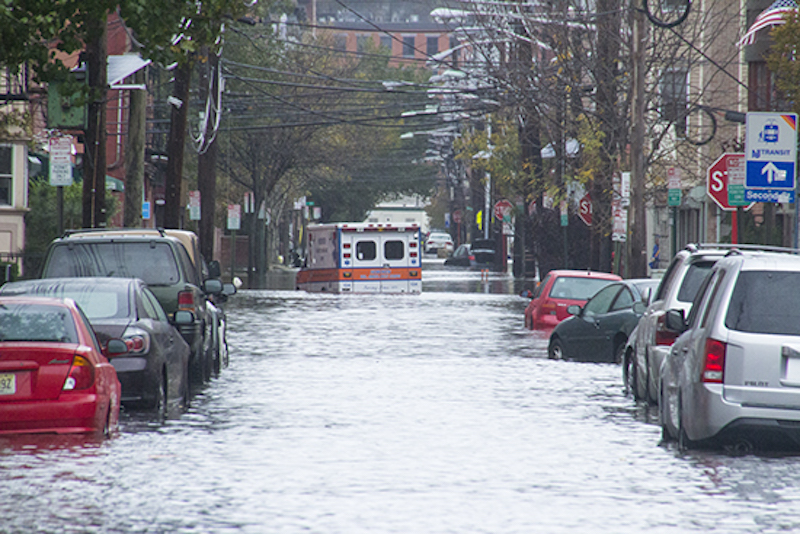AEC firms and their developer clients should be watching the progress of two bills wending their way through Congress that, if passed, could become important first steps toward opening the writing of flood insurance policies to private-sector carriers.
The U.S. House of Representatives recently passed HR 2901, the Flood Insurance Market Parity and Modernization Act of 2015, on a vote of 419-0. The U.S. Senate is currently reviewing similar legislation, SB 1679, on which it is expected to vote this summer.
The bills expand upon the controversial Biggert-Waters Flood Insurance Reform Act of 2012, which clarified the intent of Congress to get the private insurance sector to develop flood-insurance products that could compete with taxpayer-subsidized policies offered through the National Flood Insurance Program (NFIP).
That program is more than $23 billion in debt and has more than $1.1 trillion in total property exposure. NFIP’s main problem has been that it hasn’t been charging policyholders enough for flood coverage, explains Anthony Kammas, a partner with New York-based Skyline Risk Management, surety and insurance brokerage, who is also Secretary-Elect of the Professional Insurance Association (PIA).
Biggert-Waters called for the phasing out of subsidies and discounts on flood insurance premiums, and pushing more risk onto private-sector insurers and policyholders. Under Biggert-Waters, 5% of policyholders—including owners of non-primary private residences, business properties, and “severe repetitive loss properties” that are subject to redrawn floodplain maps—would have incurred 25% per year rate increases “until the true risk premium is reached.” Another 10% of policies would retain their NFIP subsidy until the owners sell their houses or let their policies lapse.
Policyholders screamed about those premium hikes, especially since the new maps put a lot more real estate within floodplains.
“It became clear that flood insurance needed to be repriced,” says Kammas. By the government agreeing ultimately to more gradual premium increases that would be priced using actuarial models, “private carriers started to think that they could make money on a primary basis.” Kammas adds that reinsurers are looking for places where they can put investors’ dollars to work.
Last month, PIA and a contingent of members spent two days on Capitol Hill meeting with lawmakers, including New York Sen. Chuck Schumer and New Jersey Sen. Robert Menendez, to urge them to support the bills that would open up the flood market to private carriers.
Kammas says the association’s goal is not to eliminate NFIP—“it will never disappear,” he says—but to make it the carrier of last resort. Kammas acknowledges that NFIP would be needed to provide flood insurance in flood-prone areas for which private carriers are less likely to offer policies. PIA also wants Congress to reauthorize the government flood program for 10 years, instead of annually, which the association believes would lend more stability to the marketplace.
Under NFIP’s “write your own” program, private carriers are allowed to service coverage that’s written by NFIP (Skyline does this). If the Senate passes SB 1679, the next step, says Kammas, would be to get private insurers engaged in offering their own flood-insurance products. (He could not provide names, but Kammas says a number of private insurers have policies that are ready to go.) The terms and conditions of such policies still need to be worked out, however, including their pricing.
“There’s a lot of work to be done, because there’s no historical information in place,” says Kammas.
He says AEC firms and developers need to be paying attention to how floodplains have been rezoned, and to make sure their policies are in compliance with their lenders’ requirements. They should also make sure that, in the event they choose to switch coverage to a private carrier, their current policies provide a continuity of coverage. And lastly, given how there’s no competitive pricing currently, policyholders would need to price-shop carefully to make sure they are getting the coverage that matches their needs at the lowest price.
Related Stories
Transportation & Parking Facilities | Oct 20, 2022
How to comply with NYC Local Law 126 parking garage inspection rules
Effective January 1, 2022, New York City requires garage owners to retain a specially designated professional engineer to conduct an assessment and file a report at least once every six years. Hoffmann Architects + Engineers offers tips and best practices on how to comply with NYC Local Law 126 parking garage inspection rules.
Mixed-Use | Oct 20, 2022
ROI on resilient multifamily construction can be as high as 72%
A new study that measured the economic value of using FORTIFIED Multifamily, a voluntary beyond-code construction and re-roofing method developed by the Insurance Institute for Business & Home Safety (IBHS), found the return can be as high as 72%.
Building Team | Oct 18, 2022
Brasfield & Gorrie chairman’s home vandalized by anti-development activists
Activists vandalized the home and vehicles of Miller Gorrie, chairman of Birmingham-based Brasfield & Gorrie, in protest of a planned $90 million, 85-acre police, fire and public safety training center in Atlanta.
Codes and Standards | Oct 17, 2022
Ambitious state EV adoption goals put pressure on multifamily owners to provide chargers
California’s recently announced ban on the sale of new gas-powered vehicles starting in 2035—and New York’s recent decision to follow suit—are putting pressure on multifamily property owners to install charging stations for tenants.
| Oct 13, 2022
Boston’s proposed net-zero emissions code has developers concerned
Developers have raised serious concerns over a proposed new energy code by the City of Boston that would require newly constructed buildings over 20,000 sf to immediately hit net-zero emissions goals.
Building Team | Oct 12, 2022
Real estate development practices worsened impact of Hurricane Ian
A century ago, the southwest Florida coast was mostly swamps and shoals, prone to frequent flooding and almost impossible to navigate by boat.
Standards | Oct 11, 2022
Peter Templeton named new USGBC and GBCI president and CEO
The U.S. Green Building Council (USGBC) and Green Business Certification Inc. (GBCI) appointed Peter Templeton as president and CEO.
Legislation | Oct 10, 2022
Chicago’s updated building energy code provides incentives for smart HVAC, water appliances
The Chicago City Council recently passed the 2022 Chicago Energy Transformation Code that is intended to align with the city’s goal of reducing carbon emissions by 62% from 2017 levels by 2040.
Contractors | Oct 6, 2022
Modular construction gets boost from impacts of the pandemic
The impact of the Covid pandemic on the construction industry appears to be fueling demand for modular construction methods, especially in the western U.S. and Canada.
Fire and Life Safety | Oct 4, 2022
Fire safety considerations for cantilevered buildings
Bold cantilevered designs are prevalent today, as developers and architects strive to maximize space, views, and natural light in buildings. Cantilevered structures, however, present a host of challenges for building teams, according to José R. Rivera, PE, Associate Principal and Director of Plumbing and Fire Protection with Lilker.

















